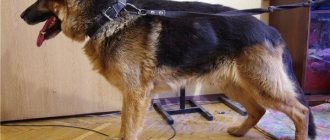Paralysis in dogs occurs when the central nervous system's ability to coordinate body movements is reduced or completely lost. Normally, the brain, spine, nerves and muscles work together to allow the dog to move normally. However, damage to the nerves that carry messages between the brain and body can disrupt complex communication pathways, causing paralysis.
A condition in which a dog lacks the ability to move all its limbs is tetraplegia, i.e. a state of complete paralysis. A condition in which a dog will have difficulty moving is called paresis - partial paralysis.
The spinal column itself is a structure of 24 bones, called vertebrae, which are separated from each other by small pads - intervertebral discs. They protect the spinal cord from damage. Injury to the vertebrae or discs can create vulnerability of the nerves in the spinal cord, leading to further injury to the nerve pathways.
Impaired motor function (paresis and paralysis) can be caused by problems with bones, joints, muscles, neurological problems and diseases of vital organs.
All cases of paralysis in dogs, even rare cases of temporary paralysis, are a cause for concern and require an immediate visit to the veterinarian. If you see signs in your dog, contact your veterinarian immediately for proper diagnosis and treatment.
Remember that even the slightest suspicion of problems with the spinal cord requires immediate contact with a veterinarian.
Symptoms of paralysis
Common symptoms of paralysis are:
- Loss of movement and/or loss of sensation in limb(s)
- Urinary/fecal incontinence
- Urinary retention
- Constipation
- Weakness of the limbs (paresis) or inability to move (complete paralysis)
- Absence of pain reaction in the limb(s)
In addition, certain diseases are characterized by certain symptoms.
- Limb dragging: radial nerve palsy
- Cold extremities, absent or difficult to detect pulse in the groin: thrombosis (blood clot)
- Dilated pupils, cough: tick paralysis
- Pain, reluctance to move: slipped disc or spinal injury
- Bloating, weight loss, fever, difficulty breathing: FIP
- Loss of appetite, lethargy: toxoplasmosis
- Neurological symptoms such as dizziness, tilted head, fixed pupils: stroke
Diagnosis of paralysis
When a dog becomes paralyzed, it needs immediate veterinary attention. Care should be taken during transportation to avoid causing further damage or injury.
- Complete physical and neurological examination for injuries and pain symptoms.
- Blood and urine tests to identify agents of infection
- X-ray/ultrasound to take pictures of the spine and brain for tumors or inflammation
- Myelogram (with dye and x-ray) for suspected disc displacement
- Abdominal fluid testing for FIP
- CT/MRI to confirm diagnosis
It may take several hours, or in some cases even days, to fully diagnose the problem.
Treatment of paralysis
Limb paralysis is an emergency and requires veterinary treatment. Your veterinarian will provide supportive care such as hospitalization, IV fluids, and oxygen therapy as needed. Steroids or anti-inflammatory drugs are usually administered to reduce inflammation in the spine.
Further treatment options for paralysis will vary depending on the cause.
Causes of paralysis in dogs
If your dog has been hit by a car or recently suffered another traumatic event, the cause of your dog's paralysis is obvious. However, sometimes symptoms can appear suddenly, out of nowhere.
Identifying the cause of canine paralysis can help your veterinarian make the correct diagnosis and outline the best course of treatment to help your pet potentially regain mobility.
There are several common underlying conditions and environmental causes that can lead to paralysis in dogs.
- Neurological condition
Polymyositis - inflammation of muscle fibers
Polyneuritis is inflammation of the nerves.
- Condition of the musculoskeletal system
Arthritis and inflammatory diseases of the musculoskeletal system.
- Genetic diseases
Intervertebral disc disease
Occurs when the shock-absorbing intervertebral discs between the vertebrae of the spinal column rupture or herniate (herniate) into the space of the spinal cord. When this happens, the discs put pressure on the nerves running through the spinal cord, which can cause paralysis.
Degenerative myelopathy
This slow-acting, progressive disease affects the nerves in the spine of older dogs, eventually leading to paralysis of the hind legs.
legs
Fibrocartilaginous embolism
A genetic disorder in large breed dogs in which a small part of a spinal disc becomes detached from the spine and blocks blood flow to a specific part of its body. This can result in painless and usually temporary paralysis that usually goes away on its own within a couple of weeks.
- Tumor
Soft tissue or bone cancer may be primary or metastatic
- Viral diseases, including plague and rabies
- Fungal diseases
- Neosporosis.
Protozoan disease caused by the protozoan parasite Neospora caninum
- Granulomatous meningoencephalomyelitis
Many inflammatory diseases of the central nervous system of animals are diffuse in nature and affect both the brain and spinal cord (encephalomyelitis and meningoencephalomyelitis)
The causes of meningitis, encephalitis and meningoencephalitis are bacteria, viruses, fungi, protozoa, rickettsia, migratory parasites, chemical agents and idiopathic or immune-mediated diseases.
- Injuries
- High exposure to pesticides and insecticides containing organophosphates
- Tick bites
Surprisingly, the main cause of paralysis in dogs is domestic causes - tick bites, poisoning and injuries.
Borreliosis (Lyme disease)
– one of the most common viral diseases in the world, transmitted by ticks, affects the brain and spinal cord and causes symptoms in only 5-10% of affected dogs.
Dominant symptoms:
- Recurrent lameness due to joint inflammation
- Fever
- General malaise
other symptoms:
- Depression
- Enlarged lymph nodes
- Lack of appetite
- Stiff gait with an arched back
- Sensitivity to touch
- Labored breathing
Diagnostics
Examination by a veterinarian to check for ticks and arthritis. Many dogs that develop Lyme disease experience periodic limps due to joint inflammation.
A clinical diagnosis of Lyme disease is usually confirmed by a positive blood test for borreliosis along with clinical signs associated with the disease. However, tests may take 4 to 6 weeks.
- Blood tests
- Complete blood cell count
- General urine analysis
- Stool tests
- X-ray
- Analysis of fluid from affected joints
Neurological examination
Neurological examination includes:
- collecting a history of the dog’s life;
- establishing the time of onset of paralysis (less than 24 hours, more than 24 hours ago, more than 48 hours);
- assessment of the mental status (degree of consciousness) of the patient;
- assessment of motor activity, presence or absence of support ability, skin sensitivity, determination of muscle tone, testing of tendon reflexes and assessment of deep pain sensitivity.
Based on the results of the examination, additional research methods may be prescribed, such as radiography, myelography, CT or MRI of the spinal cord, blood tests, virological or bacteriological studies, cytology and biochemical analysis of cerebrospinal fluid.
Ehrlichiosis in dogs
– a severe disease in dogs transmitted by ticks can lead to multisystem complications in dogs. The severity of the disease will vary depending on factors such as the duration of infection, the patient's immune status, and the strain of ehrlichia.
Symptoms
- Lethargy
- Anorexia
- Bleeding disorders (bruising or bleeding from the nose or body cavity)
- Stiff or swollen joints
- Fever
- Enlarged lymph nodes or spleen
- Difficulty breathing and cough
- Changes in the eyes
- Neurological signs
Respiratory center
Laryngeal paralysis in dogs can be either acquired or congenital. Paralysis is caused by dysfunction of the arytenoid cartilage due to functional pathologies of the caudal laryngeal nerve. Insufficient air penetrates through the glottis, which causes respiratory failure in the dog.
A hereditary predisposition is allowed in older male Dalmatians, Labradors, Rottweilers and Siberian Laikas. In turn, caudal nerve dysfunction occurs against the background of peripheral neuropathy, myasthenia gravis and endocrinopathy.
The disease is manifested by hoarse shortness of breath, cyanosis, and change in voice. In cases of peripheral neuropathy, the animal additionally experiences frequent regurgitation and causeless vomiting.
Treatment includes a diuretic and corticosteroids at an early stage. In more severe cases, there is a need for a temporary tracheotomy (opening the trachea to allow oxygen to enter). Removal of the vocal cords, unilateral lateralization and removal of part of the arytenoid cartilage are also widely used in surgery.
Anaplasmosis in dogs
is a serious tick-borne disease that can affect dogs and humans. Many dogs do not show clinical signs of anaplasmosis.
Symptoms
- Heat
- Lethargy
- Lack of appetite
- Joint stiffness and lameness
- anemia
- eye changes
Less common signs:
- Vomiting/diarrhea
- Enlarged lymph nodes
- Neurological signs
What to do if the pelvic limbs rot?
Festering most often occurs from mechanical damage to the skin when the dog moves along a rocky and hard surface. First of all, this problem can arise in kennel dogs and those kept on a chain, even in cold weather.
But you won’t be able to determine the true cause of infection on your own. The dog must be taken to the clinic for examination to assess the extent of tissue necrosis and the spread of infection.
Suppuration is treated with antibiotics in the form of injections and preparations for external treatment.
Poisoning and paralysis in a dog
If your dog is allowed to go outside, he may come into contact with poisons. Pesticides, rat poison, some plants (for example, lilies), antifreeze - all of them can be deadly to a dog, as they cause kidney failure, which causes the toxin to accumulate in the body.
In a state of toxicosis, the dog's gait may initially become unstable. As the poison continues to enter the body, other symptoms may include:
- Vomit
- Diarrhea
- labored breathing
- twitching and spasms
- paralysis of limbs
Accidents and injuries
The injury may result from an accident or shock. In cases where the motor area is not damaged, paralysis is usually temporary.
The causes of injuries are: car injuries, falls, fights with relatives. As a result, the dog may have:
- Ligament rupture or sprain
- Fracture of bone, spine, pelvis
- Dislocation of the joint
- Disc prolapse
The main cause of accidents, such as fractures or torn ligaments, occurs as a result of a sudden impact (fall). Animals most often at risk are excitable, elderly, and adventurous animals.
Immediate help
The main goals of treatment are to reduce pain, reduce the risk of additional complications, and avoid infection of open wounds. In all cases there are three basic rules:
- Do not attempt to repair a fracture or reduce a dislocation.
- Do not use antiseptics or ointments on open fractures.
- Take your dog to the vet immediately.
Paralysis caused by an accident or injury usually results in permanent damage.
Prevention of the disease
Naturally, it is better to prevent a situation than to treat it later. Once a dog is paralyzed, only the owner can help him recover. However, there are no magical remedies such as vaccinations or pills that can guarantee healing.
Owners of certain long-bodied breeds should be aware that their dogs are at risk. In this case, it is worth understanding that only a balanced diet, vitamin supplements, as well as regular visits to the veterinarian will be the dog’s (and therefore your) priority for life.
Owners must make all necessary provisions to try to reduce the likelihood of risk to a minimum. To do this, you need to monitor your pet, its diet, activity, physical and moral condition, and regularly visit the veterinarian. If you discover health problems or changes in habits that are not caused by a change in life activity, you should immediately contact a specialist. Take the following rules into account and comply with them regularly:
- Get into the habit of checking your dog for ticks after a walk. This is especially true in the spring-autumn period.
- Feed your four-legged dog fresh food, free him from the habit of picking up food.
- Teach your dog to actively react to everything that moves, runs, or flies, including birds and cats, as he may be injured in the process of chasing.
- The most common injury problem results from being chased by a motorcycle or car.
- It is worth considering even such little things as crossing the street in the right place.
Most owners are not that loyal to their pets. Not everyone agrees that the responsibility for pets lies with those who tamed them. Many people agree to live happily with their pets, however, as soon as it comes to illness, they simply refuse to put up with it.
Currently reading:
- Caring for a Dog with Degenerative Myelopathy
- Seven Signs and Remedies for Getting Rid of Fleas in Dogs
- Symptoms and treatment of vertebral discopathy in dogs
- Pinched nerves and subtle symptoms in dogs
Thromboembolism
Blood clots are most common in dogs with heart disease or cancer. About 3% of blood clots in dogs have no apparent cause, i.e. occur randomly.
A blood clot that forms in a vein or artery (thrombus) will prevent blood from flowing properly. If it forms at the pelvic end of the aorta, it is called a saddle thrombus. A dog with a sellar thrombus will have decreased blood flow to the hind legs. In this case, the symptom is sudden weakness or paralysis in one or both hind legs.
Symptoms
- Muscle weakness
- Paralysis of one or both hind limbs
Other symptoms of thromboembolism:
- Pain
- Weak pulse
- Rapid breathing
- Hindquarters are hard and cold
- Bluish or purple hue to the hind paw pads
causes
- All forms of cardiomyopathy
- Bloodstream infection (such as sepsis)
- Hyperadrenocorticism
- Protein-losing nephropathy
- Sepsis
A blood clot is a medical emergency and can be fatal if not treated immediately. The prognosis will depend on whether the clot was accidental or caused by an underlying medical condition.
Content
1. Types of paralysis of the hind limbs in dogs 2. Causes of occurrence 3. Symptoms 4. Diagnosis of paralysis of the limbs in dogs 5. Treatment process 6. Rehabilitation
Dog lovers have to deal with various ailments from time to time when caring for their pets. But the most problematic and unpleasant, although not life-threatening, is paralysis of the hind limbs in dogs. In the vast majority of cases, people think that the animal is doomed and it is not possible to help it. However, this is not always true.
Stroke in a dog
A stroke occurs when part of the brain stops receiving blood. Blood transports oxygen to brain tissue, and without it, brain cells begin to die. Blood clots or hemorrhages can cause a stroke (ruptured blood vessel).
Strokes and mini-strokes (ischemia - a temporary decrease in blood flow) most often occur in older dogs (9+ years). Symptoms may include:
- Poor balance, weakness and staggering
- Loss of coordination (walking in circles)
- Paresis/paralysis of a limb
- Head tilt
- Muscle spasms and cramps
Symptoms of stroke in dogs usually appear suddenly. Unfortunately, they are often fatal; even 30 minutes of stopping blood flow to the brain can cause permanent damage.
However, a timely visit to the veterinarian can improve the chances of recovery. A variety of treatments are available, including oxygen therapy, anti-seizure medications, and physical therapy.
Why does it occur
Impaired motor function can be caused by numerous factors. For this reason, it is often difficult to make a correct diagnosis. In most cases, the following reasons occur in veterinary practice:
- Infections (for example, toxoplasmosis or canine distemper).
- Damage to the spine due to degenerative processes or hernias. Similar ailments are mainly found in German shepherds, French bulldogs and dachshunds.
- Inflammatory diseases.
- Allergic polyneuropathy.
- Spinal cord and brain injuries.
- Acute circulatory disorders (stroke, heart attack).
- Myasthenia.
- Parasites. Tick bites are accompanied by the ingestion of substances into the animal's body that destroy neurons. The consequence is a violation of peripheral innervation.
- Encephalitis of various origins.
- Botulism.
- Benign neoplasms. If they grow to large sizes, they lead to mechanical compression of the nerve endings.
- Malignant tumors. Toxins are produced that significantly impair nerve conduction.
Paralysis in animals mainly occurs in old age due to banal wear and tear of the body.
Degenerative myelopathy in dogs
Degenerative myelopathy is a general medical term that refers to a disease of a dog's spinal cord. This disease affects the dog's central nervous system and can progress to affect the cervical and lumbar spinal cord in later stages. It has no specific cause and can develop gradually over a long period of time without symptoms. The disease can occur in dogs of any breed and age, but older animals are most often affected by this disease.
- Type II intervertebral disc disease
- Hip dysplasia
- Orthopedic diseases (disorders of skeletal and related muscles and joints)
- Degenerative lumbosacral stenosis (abnormal narrowing of the lower back spine or pelvic bone)
Symptoms
- Increased muscle atrophy and inability to maintain posture
- Partial or complete paralysis of the limbs
- Loss of ability to control bowel movements and urination
- Exaggerated spinal reflexes
- Loss of muscle mass
Diagnostics
- Visualization
- Blood tests (general, biochemical and hormone tests)
- Magnetic resonance imaging (MRI)
- Computed tomography (CT)
Treatment
- Maintenance therapy (there are currently no medications approved to treat this condition).
- Physical exercise
- Diet (to prevent pressure on the spine, avoid weight gain).
Overall, the long-term prognosis is poor for animals diagnosed with this disease as it is degenerative in nature.
Jaws
This is the second name for trigeminal nerve palsy. The essence of the disease is impaired innervation of the masticatory muscles. Sometimes it occurs in parallel with facial paralysis.
They provoke inflammation of the middle ear, tumors and abscesses in the brain, hemorrhages, dental diseases, distemper, rabies, fractures of the lower jaw, and feather grass disease.
Jaw paralysis can be unilateral or bilateral. In case of one-sided disease, the dog's jaw droops slightly, chewing is difficult, and the incisors shift to the paralyzed side. Bilateral paralysis is characterized by the inability to close the mouth, drink water, and chew.
The transition to a chronic form causes complete atrophy of the masticatory muscles. The prognosis in this case is unfavorable.
Hip dysplasia in dogs
Hip dysplasia is a genetic disease that causes abnormal development of the pelvic bones. With dysplasia, the articular head does not coincide with the socket, which prevents normal movement of the head. This is a hereditary disease that is passed from parents to the puppy. Although the condition is present from birth, it is often not diagnosed until later in life.
Symptoms
- Unsteadiness and unnaturalness when walking
- Difficulty jumping
- Appearance of lameness (temporary or permanent)
- Curvature of limbs
- Decrease in activity
- Muscle atrophy (due to which the limbs become thin and weak)
- Strange gait with leaning to one side
- Crunching of bones when moving.
Diagnosis and treatment
Hip dysplasia is diagnosed through physical examinations and radiographs.
Depending on the severity of the disease, the dog is prescribed a certain type of treatment. It is important to remember that dogs with joint dysplasia need to adjust their lifestyle by eliminating jumping and physical activity.
- Diet
During treatment, the animal's food should be enriched with glucosamine and chondroitin, which are found in cartilage, salmon and salmon, mussel shells, and gelatin.
- Surgery
Triple osteotomy, resection arthroplasty, prosthetics
- Physiotherapy
At the initial stage of the disease, the animal may be prescribed physical treatment. After surgery, ultrasound is used, which promotes bone healing and relieves inflammation. Electrical stimulation gives the animal an analgesic effect, and laser therapy helps restore collagen in cartilage tissue. Massage promotes blood flow and saturates tissues with oxygen.
- Drug treatment
In cases where dysplasia has complex forms and in advanced cases, the dog is prescribed anti-inflammatory drugs, painkillers, and vitamins.
Rehabilitation
All procedures aimed at rehabilitation begin only with the permission of a veterinarian.
- If the hind legs, front legs or the whole body are paralyzed, the dog is prescribed a massage. The owner, under the supervision of a specialist, can independently carry it out daily for 5-15 minutes several times a day. The exact number of approaches is determined by the veterinarian monitoring the pet’s condition.
- Infrared heating has an excellent effect on weakened muscles that lack motor activity. This type of physiotherapy, such as swimming in a pool, speeds up the process of restoring neural connections.
- To support the dog, you will need special harnesses attached to the body. With their help, the pet is protected from sudden falls.
- Unfortunately, anything can happen. Sometimes the treatment and rehabilitation process does not bring the desired results. The owners refuse to put up with the current situation, buy a wheelchair or make it themselves. The device helps the animal to move successfully.
The dog's food after surgery for laryngeal paralysis should be soft. It is imperative to exclude liquid from the feed. The main goal is to provide the patient with a diet that is easy to swallow. It is necessary to ensure that there is free access to a bowl of water and to control the ingestion of food by the animal. Feeding is carried out in small portions, several times a day.
Arthritis in dogs
Arthritis is a degenerative disease of the joints. It is characterized by inflammation and deterioration of the joints. May develop after infection or injury to a limb and inevitably worsens with age.
It is usually characterized by age-related wear and tear on the joints. It is seen in older dogs, although it can affect dogs of all ages. Arthritis symptoms appear slowly.
Symptoms
- Stiff limbs or limping when walking
- Lethargy
- Reluctance to jump and play
- Lack of care or excessive care of a diseased joint
Causes
- Injury that caused short-term lameness and pain
- Hip dysplasia
- Autoimmune diseases
- Obesity
Diagnosis and treatment
Arthritis is diagnosed using x-rays and physical examinations. Although there is no cure for arthritis, painful symptoms can be relieved and made more manageable. For example, losing weight can relieve pressure on joints, and pain medications can reduce discomfort.
Recovery period from paresis
The recovery period is a complex process that involves, first of all, exercises that will allow the pet to at least move its limbs with partial compression and release of its paws. However, this does not mean at all that it is time to start running. The process of even walking after paralysis in dogs will require a lot of patience and physical effort.
Daily short-term training for 5-15 minutes, limited by the dog’s ability. At the same time, it is worth strengthening the dog’s diet by diversifying it with calcium. Recovery also involves moral support: please the dog with a loyal attitude, stroke its belly, play with it to the best of its ability. It is important to understand that learning to walk again is not so easy, and you are the only chance for this.
Based on practice, rehabilitation of psychomotor functions (the ability to walk) occurs quickly, however, first you should support a pet that will stumble and refuse to walk. Of course, when your pet weighs 30 kg or more, you have a certain risk of “straining yourself” during regular training with your four-legged dog.
As specialized equipment for dog sports equipment, you can use a dog carrier or cart. Such a cart is based on the size of the dog itself, so that he can work independently with his paws. Regarding special devices for dogs during the rehabilitation period, little can be said. An ordinary pet store does not sell such goods, due to problems with choosing the volume of the device itself, as well as high prices.
In this case, you can use your wits and try to solve the problem yourself, say, using a standard sports bag from the store and scissors. How? Using scissors, we cut everything to the shape, leaving the sides, handles and fasteners from the bag, if necessary, add elastic bands. That's it, the carrier is ready.











